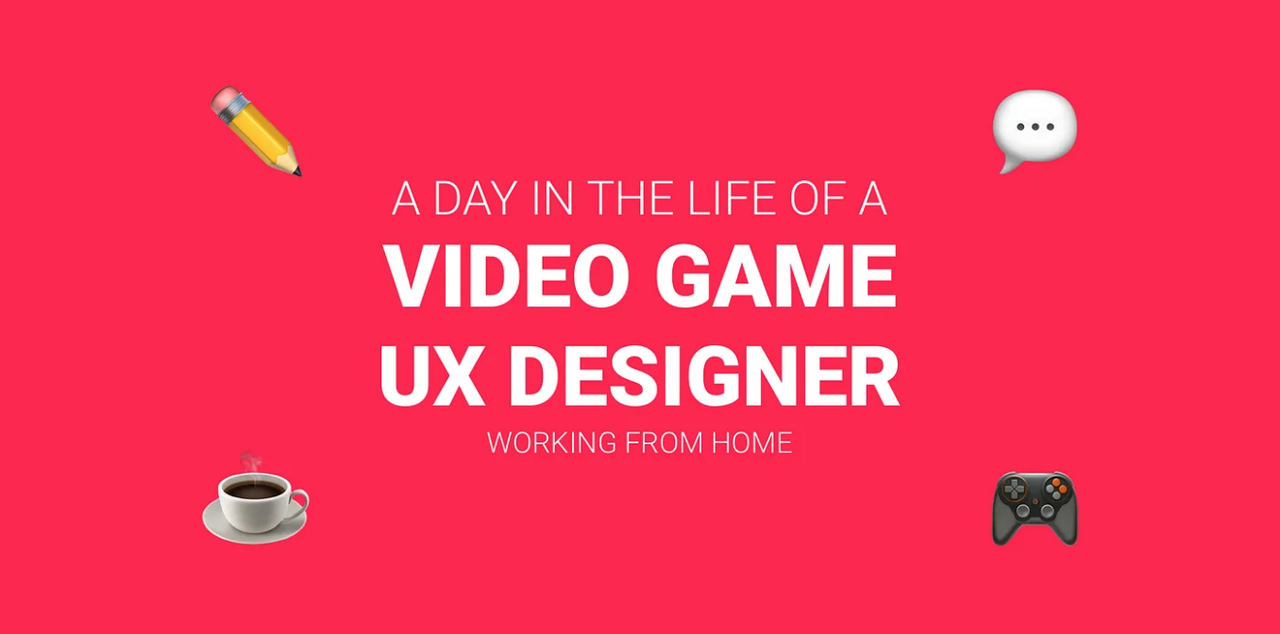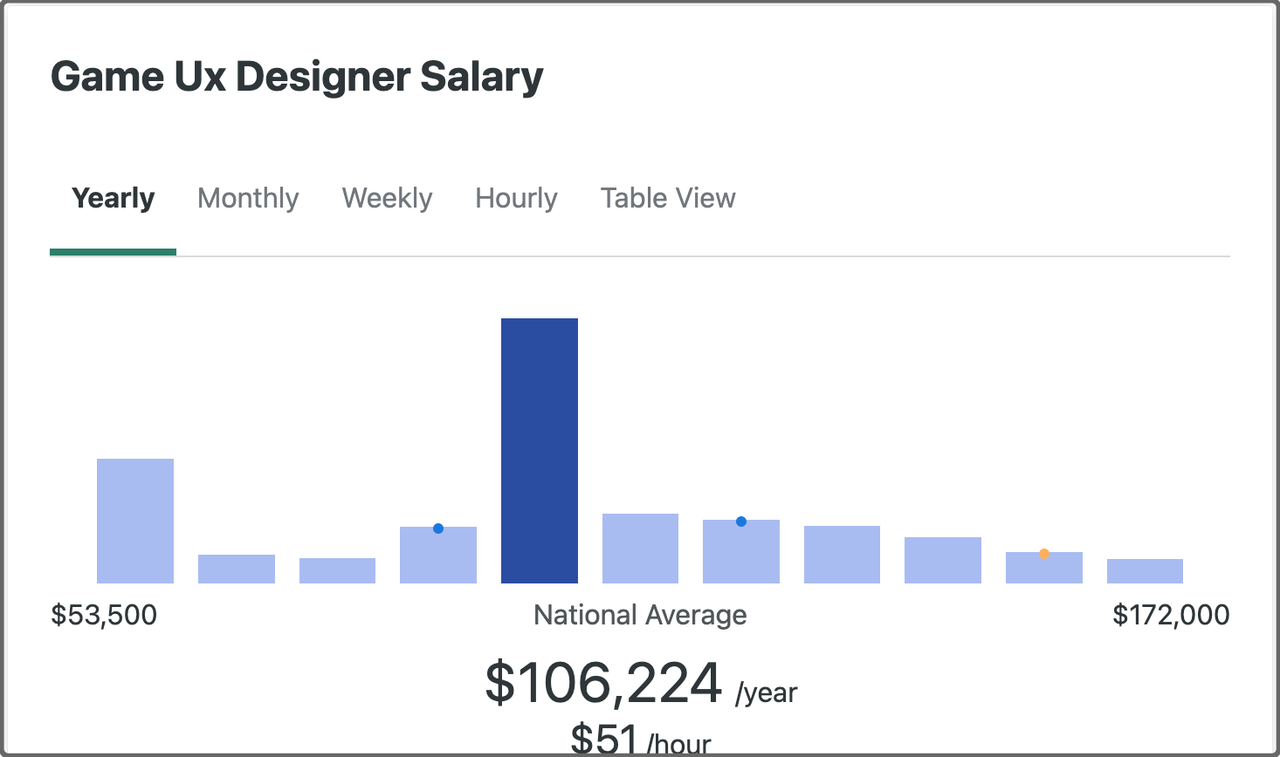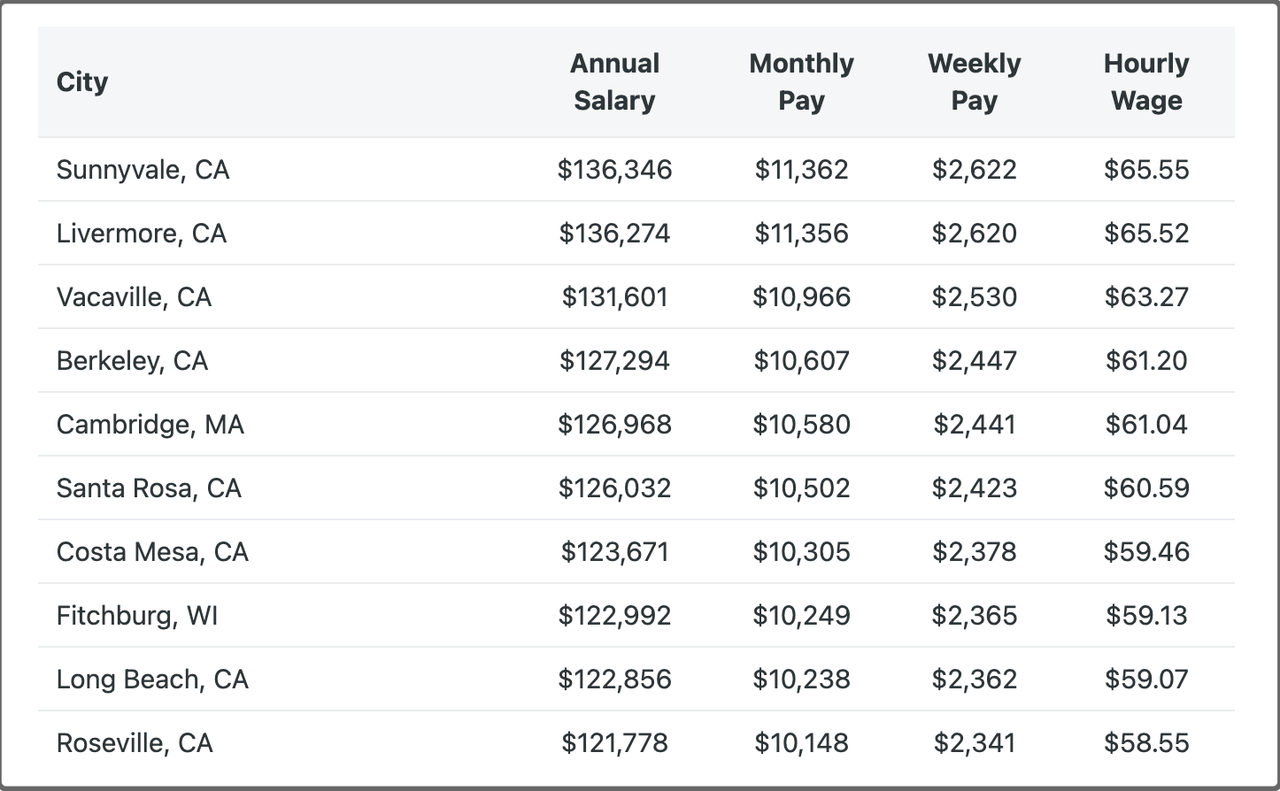The gaming industry's significant success translates into abundant opportunities for UX designers. Games, like apps and websites, depend on user interfaces crucial for a seamless, intuitive, and enjoyable experience. As the gaming landscape continues to evolve, UX designers play a pivotal role to create an enjoyable and immersive gaming experience.
This article explores what exactly game UX design is. It covers fundamental aspects such as the definition and significance of game UX design, offers insights into typical salaries for game designers, elaborates on key roles and responsibilities within the realm of game UX design, examines the current job market outlook, and concludes by outlining actionable steps aspiring individuals can take to secure a position as a game UX designer.
Game UX design, also known as Game User Experience design, is a meticulous process dedicated to crafting interactive elements and overall user experience within a game, with a particular emphasis on video games.
This multifaceted discipline spans the entirety of a player's interaction with a video game, encompassing critical elements like the game's interface, controls, gameplay mechanics, visuals, audio, and overarching design.
The primary goal of game UX is to go beyond functionality; it aims to create an immersive and enjoyable experience that captivates players. The success of game UX is measured by its ability to not only satisfy but to sustain interest and motivation, encouraging players to continue engaging with the game over an extended period.
In essence, game UX design is the art and science of orchestrating every aspect of a player's journey, ensuring a seamless and captivating gaming experience.

What is game ux design
While game designers focus on crafting gameplay mechanics, challenges, and narrative elements, game UX designers dedicate their efforts to optimizing the user interface (UI), controls, menus, and navigation for a seamless and enjoyable player experience.
This optimization considers factors such as intuitiveness, accessibility, and the overall user journey within the game. Additionally, Game UX designers play a crucial role in onboarding new players by providing instructional guidance and contextual information to enhance understanding and engagement.
The ultimate aim of Game UX design is to establish an immersive, user-friendly environment that heightens player satisfaction and encourages sustained engagement with the game. Here's a deeper exploration:
Interface and Controls:
Game UX designers delve into the creation of intuitive interfaces and controls that seamlessly connect players with the game world. From menu navigation to in-game actions, the interface and controls are crafted for accessibility, ease of use, and responsiveness.
Gameplay Mechanics:
The underlying systems and mechanics of gameplay are another focal point. Game UX designers work to refine and optimize these elements, ensuring they align with the overall game objectives while providing an engaging and dynamic experience for players.
Visuals and Aesthetics:
Visual appeal plays a pivotal role in Game UX. Designers curate the aesthetics, including character design, environments, and visual effects, to not only please the eye but also to enhance the storytelling and emotional impact of the game.
Audio Design:
Sound is an integral part of the immersive experience. Game UX designers collaborate with audio experts to create a harmonious blend of music, sound effects, and dialogue that enhances the atmosphere and evokes emotional responses from players.
Overall Design Cohesion:
Achieving cohesion across all elements is paramount. Game UX designers strive for a seamless integration of visuals, audio, controls, and mechanics, creating a unified and coherent experience that resonates with the game's overarching theme and narrative.
Player Engagement and Retention:
Beyond individual elements, Game UX design is inherently focused on player psychology. Techniques are employed to captivate and retain players' interest, encouraging them to invest time and emotion into the gaming experience.
User Testing and Iteration:
The iterative nature of Game UX design involves continuous testing with real players. This hands-on approach allows designers to gather valuable feedback, identify areas for improvement, and refine the user experience to meet the evolving expectations and preferences of the gaming community.
In essence, Game UX design is an artful blend of creativity, technical expertise, and a profound understanding of player behavior. It seeks not only to meet but to exceed player expectations, creating a world where every interaction is not just a moment in the game but a memorable part of a captivating journey.
Now, let's explore the specific responsibilities and tasks that occupy the daily work of game UX designers.
User Research: Conducting extensive user research to unravel the intricacies of player needs, preferences, and behaviors. This information serves as a foundation for making informed and strategic design decisions.
Prototyping: Generating wireframes, prototypes, and various design documents to facilitate effective communication and iterative development, providing a tangible representation of envisioned user experiences.
UI Design: Architecting user interfaces and menus that transcend mere functionality. Emphasis is placed on intuitive design, ease of use, and a visually captivating aesthetic, enriching the overall user experience.
Product Documentation: Developing comprehensive game tutorials and onboarding experiences to proficiently introduce players to intricate game mechanics and controls, ensuring a smooth initiation into the gaming world.
Collaboration: Working collaboratively with game developers, artists, and team members to ensure consistency and cohesiveness in game mechanics, user interfaces, and overall design elements. This collaborative effort is crucial for a unified and immersive gaming experience.
Testing: Conducting meticulous testing and evaluations with players to pinpoint nuanced areas for improvement. This iterative feedback loop guides the design process, steering it toward continuous enhancements.
Iteration and Optimization: Prioritizing accessibility and inclusivity in design choices to maximize playability for a broad audience. This iterative refinement process ensures that the gaming experience remains engaging and accessible to diverse player demographics.
Task Management: Collaborating closely with game producers to masterfully manage design schedules and prioritize tasks. This strategic coordination ensures alignment with overarching project objectives and timelines, contributing to the seamless execution of the design process.
In essence, Game UX designers navigate a dynamic landscape that demands a blend of creativity, technical prowess, and a deep understanding of player psychology. The iterative nature of their work, coupled with collaboration and strategic decision-making, culminates in the creation of immersive and memorable gaming experiences.

Ux game designer
In light of the gaming market's immense popularity, game UX designers command competitive salaries, subject to variations based on factors such as location, experience, education, and specific job roles.
According to ZipRecruiter data as of November 24, 2023, the average annual pay for a Game UX Designer in the United States is $106,224. On an hourly basis, this translates to around $51.07, or a weekly income of approximately $2,042 and a monthly earning of $8,852.
The salary spectrum for Game UX Designers is diverse, with annual earnings ranging from as high as $172,000 to as low as $53,500. The majority of salaries fall between $91,000 (25th percentile) and $125,000 (75th percentile). Top earners in the 90th percentile can command an annual income of $152,000 across the United States. These figures underscore the range of earning potential within the field, reflecting the impact of various influencing factors on Game UX Designer salaries.

Game ux designer salary
ZipRecruiter has identified the top 10 highest-paying cities for Game UX Designer Jobs, shedding light on geographical variations in compensation. Topping the list is Sunnyvale, CA, renowned for its thriving tech industry and home to major gaming companies. Following closely are Livermore, CA, and Vacaville, CA, securing second and third positions, respectively.

Top 10 highest paying cities for Game UX Designer Jobs
Furthermore, it's crucial to recognize that actual salaries may vary based on the designer's location and individual circumstances. Additionally, compensation packages for Game UX Designers often include various components such as bonuses, profit-sharing, and stock options, contributing to the overall remuneration package.
This underscores the importance of considering the broader context and additional benefits when evaluating the financial aspects of a Game UX Designer's role.
The outlook for game UX designers remains optimistic, propelled by the swift expansion of the gaming industry. The demand for proficient game UX designers is poised for sustained growth in the coming years.
As per ResearchandMarkets data, the Game Development Software Market exhibited substantial growth, with an estimated value of USD 1.15 billion in 2022, projected to reach USD 1.26 billion in 2023. The market is anticipated to maintain this upward trajectory, growing at a CAGR of 10.12% and reaching a substantial value of USD 2.49 billion by the year 2030. The cost of outsourcing game art in general is consistently growing.
This data underscores the robust and promising future for game development, highlighting the significance of skilled UX designers in contributing to the industry's continued success.
Furthermore, the global video game market is experiencing rapid expansion and transformative changes driven by innovations in cloud gaming, augmented reality, virtual reality, and AI. These advancements are not only shaping new monetization models but also creating additional avenues for game UX designers.
Acknowledging the crucial role played by game UX designers in the success of a game, development studios recognize it as an indispensable element for their teams. As a result, aspiring game UX designers find themselves in an environment filled with abundant opportunities, promising a fulfilling and stable career.
The dynamic landscape of the gaming industry, characterized by ongoing technological advancements, reinforces the importance of skilled UX designers in shaping the future of interactive and immersive gaming experiences.

Game ux design promising future
UX (User Experience) and UI (User Interface) game design are closely related but distinct aspects of the overall game development process.
Focus: UX design is dedicated to the holistic experience and satisfaction of the player throughout the entire gaming journey. It extends its influence across the entirety of the player's interaction with the game.
Components: Encompassing a diverse range of elements, including game mechanics, narrative flow, player engagement strategies, and the overall enjoyment derived from the gaming experience. UX design takes a comprehensive approach to shaping the player's encounter.
Objective: The primary objective of UX design is to craft a gaming experience that is not only seamless and enjoyable but also immersive. It aims to ensure players not only find satisfaction but are motivated to continue their gaming journey.
Influence: UX design goes beyond the tangible elements, delving into the emotional and psychological connection players forge with the game. It is a masterful orchestration that influences how players perceive, engage with, and ultimately connect on a deeper level with the gaming universe.
Focus: UI design zeroes in on the visual elements and interactive components that players directly encounter and engage with throughout the gaming experience.
Components: Encompassing a diverse array of elements such as menus, buttons, icons, heads-up displays (HUDs), and other on-screen features meticulously designed to facilitate seamless player interaction.
Objective: The primary goal of UI design is to create an intuitive and user-friendly interface. This interface serves as the navigational compass for players, enabling them to effortlessly traverse the gaming environment while comprehending crucial information effortlessly.
Influence: UI design holds the reins of how players interact with the game on a visual and interactive level. It significantly impacts the interpretation of in-game information, shaping the player's understanding and overall engagement. A well-crafted UI becomes an integral part of the gaming journey, enhancing the overall experience.
In summary, while UX design looks at the holistic player experience, encompassing emotions, engagement, and overall satisfaction, UI design focuses on the specific visual and interactive elements that contribute to a smooth and accessible user interface within the game. Both aspects are crucial for creating a successful and enjoyable gaming experience.

Game ux design is different than game ui design
Step 1: Start from obtaining an educational background
Pursue a relevant degree: Consider obtaining a degree in fields such as game design, interaction design, human-computer interaction, or a related field.
Gain knowledge in game development: Familiarize yourself with the fundamentals of game development, including understanding game mechanics and player behavior.
Step 2: Build core skills
Develop UX skills: hone skills in user research, wireframing, prototyping, usability testing, and other UX methodologies.
Gain proficiency in design tools: Become adept at using design tools like Mockplus, Sketch, Figma, Adobe XD, or others commonly used in the industry.
Learn game design principles: Familiarize yourself with game design fundamentals, including player psychology, game mechanics, and narrative structures.
Step 3: Build a portfolio
Create a portfolio: Showcase your skills by developing a portfolio that includes examples of your UX design work. Highlight projects related to games or interactive experiences.
Step 4: Gain practical experience
Internships or Entry-Level Positions: Look for internships or entry-level positions in game development studios. Practical experience is invaluable for understanding the industry and refining your skills.
Step 5: Build networking
Attend industry events: Participate in conferences, meetups, and events related to game development and UX design. Networking can open up opportunities and provide insights into the industry.
Step 6: Apply for positions
Search for openings: Look for job openings or freelance opportunities that align with your skills and interests.
Tailor your applications: Customize your resume and portfolio for each application, emphasizing relevant experience and skills.
Besides, please always remember that becoming a game UX designer is a continuous journey of learning and adapting to industry trends. Continuous learning is important. Take online courses, join in game design and development communities, attend workshops, and read books and articles on the subject to keep up with the latest trends in both UX design and game development.
1.Can a UX designer become a game designer?
Yes, a UX designer can transition into a game designer role, but it may require acquiring additional skills and knowledge specific to game design. Here are steps that a UX designer can take to become a game designer:
Understand Game Design Principles: such as game mechanics, level design, player engagement, and narrative development.
Gain Knowledge of Game Development: understanding how different elements come together to create a cohesive gaming experience.
Learn Game Development Tools: acquire proficiency in game development tools commonly used in the industry, such as Unity, Unreal Engine, or other relevant software.
Participate in Game Jams: engage in game jams or collaborative game development events.
Collaborate with Game Developers: networking and working with experienced game developers can provide valuable mentorship and insights.
Acquire Additional Skills: such as scripting, 3D modeling, or animation, depending on the specific aspects of game design you want to focus on.
2.Do game designers need to code?
Coding skills, while advantageous, are not always mandatory for game designers.
Instead, possessing a foundational understanding of coding concepts proves highly beneficial in the collaborative environment of game development.
Game designers find value in having a basic grasp of coding, as it facilitates seamless communication with developers. This shared understanding fosters effective collaboration and enables designers to convey their creative visions more clearly to the development team.
The necessity for game designers to code varies based on the specific role they undertake and the expectations of the development team. While some designers may engage in coding tasks to a certain extent, others may focus more on conceptualizing gameplay mechanics, narrative elements, and overall user experiences without delving extensively into coding complexities.
Ultimately, the degree of coding involvement depends on the unique requirements of the game development process and the collaborative dynamics within the team.
3.Is it hard to get a job in game design?
Getting a job in game design can vary in difficulty depending on several factors, including your skill set, experience, the demand in the industry, and competition. Here are some considerations:
Education and Skills:
A relevant educational background in game design, coupled with a strong skill set showcased in a comprehensive portfolio, enhances your prospects. Employers often seek candidates with a solid foundation and practical abilities in game design.
Portfolio Quality:
The quality of your portfolio is paramount. It should effectively highlight your creativity, problem-solving skills, and a deep understanding of game design principles. A compelling portfolio sets you apart in a competitive field.
Networking:
Building connections within the gaming industry is invaluable. Attend networking events, conferences, and engage in online communities to establish relationships that can lead to job opportunities and collaborations.
Internships and Entry-Level Positions:
Starting with internships or entry-level roles provides hands-on experience and serves as a stepping stone to more advanced positions. It also allows you to build a practical understanding of the industry.
Location and Industry Demand:
Job availability is influenced by your location and the demand for game designers in that region. Being aware of industry hotspots and considering relocation if necessary can impact your job prospects.
Versatility and Specialization:
Demonstrating versatility and openness to different facets of game design can broaden your appeal. However, specialization in specific areas of game design can also make you stand out for particular roles.
Persistence:
Landing a job in game design often requires persistence. The process may take time, and facing rejection is part of the journey. Consistent efforts, continuous skill development, and adapting to feedback contribute to eventual success.
In summary, a combination of education, skills, networking, practical experience, adaptability, and persistence are crucial elements in navigating the competitive landscape of game design employment.
Pursuing a career as a UX game designer in the gaming industry can be highly rewarding. To become successful in this role, focus on expanding your knowledge, gaining experience, building a strong portfolio, and networking with industry professionals.
Understanding the distinction between UX and UI designers and their specific roles in the game industry is essential. With a solid portfolio and a robust set of skills, you can stand out among game designers and make a significant impact in the field.
In- house content editor, specialize in SEO content writing. She is a fruit lover and visionary person.
 Mockplus Cloud
Mockplus Cloud
Uploads design files from Sketch, Figma, Axure, Photoshop, and Adobe XD into our design handoff tool.
 Mockplus RP
Mockplus RP
A free online prototyping tool that can create wireframes or highly interactive prototypes in just minutes.
